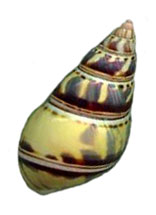|
Hybrids of Liguus Color Forms |
 |
|
Hybrids of Liguus Color Forms |
 |
The richness and variety of coloring of the Liguus
has led to the recognition and naming of many
species, subspecies, forms and varieties. The following is a discussion of known hybrids
between
the described and accepted color forms. The Photo Pages, linked to the Hybrid Listing,
show
specimens of hybrid forms and specimens of the parental forms.
Home Page
- Geographic Distribution - Ecology - Taxonomy - DispersalHybrid Listing
(Click on the Linked Names for Photo Pages)
Page - - - - - - - - - Contents
1) - Liguus f. graphicus variety osmenti x Liguus f. testudineus variety castaneus
1) - Liguus f. graphicus variety dryas x Liguus f. solidus variety pseudopictus
2) - Liguus f. testudineus variety margaretae Jones, 1979 (a named hybrid)
2) - Liguus f. testudineus variety beardi ? Jones, 1979 (a named hybrid)
3) - Liguus f. testudineus variety wintei ? Humes, 1954 (a named hybrid)
3) - Liguus f. testudineus variety fuscoflamellus Frampton, 1932 ( a natural hybrid)
4) - Liguus f. testudineus variety kennethi ? Jones, 1979 (a named hybrid)
4) -Liguus f. ? hybrids of unknown parental forms
Liguus Hybrids; a Topic for Discussion
The hybridization of described and accepted Liguus (species, subspecies, forms and varieties)
(1), several others,
occurs naturally, has been accomplished intentionally and has happened as a result
of snail introductions or "plants". Unfortunately few of these instances have been documented.
Only one instance of controlled breeding was documented by Dr. Hillis
though documented by Archie Jones (2), were not carried out under controlled conditions.
It is assumed the visitor to this site has read much of the literature on Liguus so I will be
brief in the reproductive background and composition of "color forms" within Liguus
colonies and populations.
The Liguus is a hermaphrodite, that is, it is both male and female. The snail requires
copulation with another snail for fertilization to occur, also some degree of self fertilization
is effected during or after copulation (3).
Liguus colonies are either pure; a single "color form" (species, subspecies, form or variety)
or they are mixed; two, three, four or more "color forms". There are no intergrades
between the forms comprising the population of established colonies. As an example; a colony
comprised of roseatus and marmoratus does not contain intergrades between these forms,
however there are intergrades/variations (light to dark, etc.) within a form.
Some of the hybrid forms shown on these pages are results of matings between distant and
isolated colony/populations and some are re-creations of naturally occurring forms
which have been established as true breeding colonies.
This information may not be too well documented but it is interesting and intended to stimulate
further discussion and study of this interesting snail and its zoogeography.
(1) Hillis, D.M., D.S. Rosenfeld and Modesto Sanchez, Jr., 1987. Allozymic Variability
and Heterozygote Deficiency Within and Among Morphologically Polymorphic
Populations of Liguus fasciatus (Mollusca:Pulmonata:Bulimulidae).
American Malacological Bulletin, Volume 5(2), pages 153 - 157.
(2) Jones, A.L., 1979. Descriptions of Six New Forms of Florida Tree Snails, Liguus fasciatus.
The Nautilus, Volume 93(4), pages 153 - 159, color plate.
(3) Hillis, D.M., M.T. Dixon and A.L. Jones, 1991. Minimal Genetic Variation
in a Morphologically Diverse Species (Florida Tree Snail, Liguus fasciatus).
Journal of Heredity, Volume 82 (4), pages 282 - 286.
Please e-mail comments or discussion to: Emilio Jorge Power (ejpower@ix.netcom.com)
Home Page
- Geographic Distribution - Ecology - Taxonomy - Dispersal